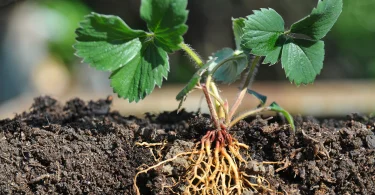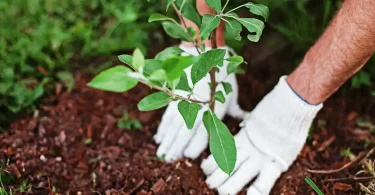Dahlias are bright, diverse, and beautiful flowers that look great in any garden, on a balcony, or on a patio. A favorite of gardeners for many centuries, dahlias are famed for stunning flowers that can be rather large and are available in a range of shapes and colors. Even though these flowers are usually planted in the ground, dahlia can be successfully grown in containers, so let’s have more people who wish to plant these flowers at home. This article will then discuss how to grow dahlias in pots; including the types, soil, protection, and care.

Why Grow Dahlias in Pots?
Growing dahlias in pots offers several advantages:
1. Space Flexibility:
Although dahlias can be grown from seeds, tubers, or even transplants, for people who have small spaces to rear their plants, growing them in pots is graceful because not everyone lives in a big house or lots of space with a garden bed.
2. Mobility:
One advantage of growing dahlias in pots is that they can be easily repositioned to escape prevailing inclement weather, to be placed where they can get the best amount of light, or just because they have been rearranged for decorative purposes.

3. Pest Control:
One way of practicing this is by growing dahlias in pots whereby the chances of pests and diseases are minimized. container gardening makes it easier to monitor the type of soil to be used and the water it retains and due to this, it discourages the common pests such as slugs, snails, and aphids in the dahlia plants.
4. Customization:
It is easy for gardeners to quantify soil and hence provide an important environment favorable for the growth of dahlias in pots.
Selecting the Right Variety
When selecting dahlias for pots, it is necessary to remember about size and habits of the plant. Dahlias come in all sorts of sizes from the dwarf which grows up to 12 inches, the medium-sized which grows up to 24 to 36 inches, and the giant which grows up to more than 60 inches tall. Some characteristics you need to look for include compact growth habits and rounded forms when it comes to container gardening.
1. ‘Gallery’ Series:
These dahlias are raised in containers that are normally used in planting flowers. It is a small plant that does not usually exceed 12-18 inches and blooms profusely.
2. ‘Mignon’ Dahlias:
These are small-flowered dahlias, ideal for pots because they grow to a limited size and bloom profusely. ‘
3. Bishop of ‘Llandaff’:
Slightly bigger, this type features dark leaves and bright crimson flowers that look perfect on any patio.

Choosing the Right Pot
This section will discuss the importance of selecting an appropriate pot when growing dahlias.
Size:
For small varieties, select a pot that is not less than 12 inches in diameter and 12 inches deep. In larger varieties, one should use a pot 18-24 inches in diameter and depth. The pot size is significant because Dahlias have a tuberous root that needs ample space for growth and development.
Material:
It is also important to note that pots can be created using different materials such as plastic, terracotta, and ceramic. This is because the terracotta pots enable free circulation of air in the pots as well as provision of enough drainage for the dahlias. Although they can become dry rather fast, therefore they may require frequent watering. Plastic pots hold water longer than the soil does and they are also lightweight hence easy to transport.
Drainage:
This makes it possible to check on the drainage holes in the pot to avoid conditions that may lead to waterlogging and therefore root rot. It has been suggested that it is possible to place a layer of gravel at the bottom of the pot to enhance drainage.
Preparing the Potting Mix
Dahlias, as it was mentioned before, need soil that is well-draining and has a good amount of organic matter. The potting mix of dahlias needs to be one that will hold moisture but at the same time will not lock moisture to the roots of the plant. Here’s a recommended mix:
- 1 part garden soil
- 1 part compost or rotted well manure
- 1 part perlite or builders coarse sand
Stir these components well before you pack the pot because the blend of proper ingredients supplies the plants with the nutrients they need and well-developed roots.

Planting Dahlias in Pots
Planting Time:
Dahlias are usually grown from tubers and the plants are generally set out in the spring once the frost is over. In cooler regions, an option is to grow dahlias in pots and transplant them into the outdoors when the climate becomes right.
Planting Depth:
Put the dahlia tuber with the grown side facing upwards in a hole in the center of the pot to a depth of 4-6 inches. Its growth point – the tuber ‘eye’ – should be upwards. Bury the tuber in soil to the top leaving a space of about an inch from the rim of the pot which is for watering purposes.
Spacing:
If you’re planting several tubers in a container, space them in such a way that they will receive adequate space to develop without struggling with the rest of the plant. Though this method works well, it is also possible to place one tuber in each pot to allow the plant to grow well.
Watering and Fertilizing
Watering:
Container-grown dahlias should be watered as often as possible especially when there are signs of drought. When the soil is dry, at least an inch down, it is the right time to water the plants. It is correct to water the plant from below the stalks in order not to contribute to the development of fungal diseases.

Fertilizing:
Dahlia plants are also fast and insatiable growing plants that require a frequent supply of fertilizers. Water-soluble balanced fertilizer has to be applied every three to four weeks. It is possible to use a slow-release fertilizer incorporated into the potting compost at the time of planting. Use care when using fertilizers with high nitrogen content as it will cause lush growth of the foliage at the expense of the flowers.
Staking and Support
The taller types of dahlias are going to need staking, just for the support, as they grow. Drive a stake into the pot at the time of planting so as not to hurt the tuber in the future. Tie the stems gently to the stake with soft knots so that the stem of the plant has the support it needs without being bound.
Sunlight Requirements
Dahlias do best in full sun and will need at least 6-8 hours of sun exposure a day. Choose an area well exposed to sun and put the pots accordingly. During a hot summer where the afternoon sun is too hot, some shade especially in the afternoon is advisable in order not to fade the blooms or scorch the foliage.

Overwintering Dahlias in Pots
Dahlias are not frost-hardy and thus, in areas that receive cold winters, they are usually grown as annuals. However, with proper care, you can overwinter your dahlias and replant them the following spring:
Cutting Back:
The second trim should be done after the foliage is browned by the first frost and is cut back leaving 4-6 inches above ground level.
Drying:
Take the pots to a sheltered area where there is no freezing temperature like a garage or basement. After cultivation, allow the soil to dry before pulling out the tubers to be stored. Or you can gently pull the whole thing out from the ground, wash the roots off, and allow the tubers to dry in another cool dry area.
Storage:
Put the tubers in a carton and cover them with peat, vermiculite, or sawdust so do not dry up completely. Stow them in a cool, dry spot and leave them alone until the spring.
Common Problems and Solutions
1. Pests:
Some of the main diseases that threaten dahlias include the following: Aphids Slugs and Angles Spider Mites. Spray your plants often to check for pests and as soon as you spot them, use insecticide soap or neem oil to control them. Hand-picking and the use of slug bait can be used to control the number of slugs in the garden.

2. Diseases:
Dahlias are susceptible to powder mildew and botrytis – both of which are fungal diseases. Some of these diseases include dampness, late blight, and powdery mildew, so make sure there is adequate ventilation around the plants and do not water them from above. There may be instances where fungal disease appears, to eradicate this, one has to prune out the affected leaves and use fungicides if the disease persists.
3. Weak Stems:
This could be a result of inadequate light or overfeeding with Nitrogen to the Dahlias with weak stems. Make sure that your dahlias are in the right position to receive adequate light; also play around with the schedule for feeding to record better growth.
Conclusion
Dahlias for containers is one of the most stimulating and joyful projects for people who like to garden at home, no matter if they have only a small balcony or a vast terrace. Dahlias are really pretty flowers that you can strive for depending on the type of pot you use, the kind of soil you use, and the level of care you give it throughout the growing season. When it comes to growing these flowers in containers, even individuals new to gardening can easily achieve this by using various suggestions in this guide to come up with a bright, saline, and powerful floral display that will dazzle everyone who comes across it. Read more…



